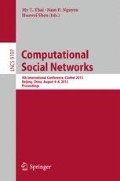Abstract
Link prediction in complex networks has attracted increasing attention of researchers in many domains. The prediction methods are usually used to find missing information, identify spurious interactions, and reconstruct networks. Inspired by the rich-get-richer mechanism, we propose a novel index on the basis of betweenness. Extensive experiments show that the proposed method performs well on some networks. Especially, on the Adjnoun network and Florida network, it outperforms some mainstream link prediction baselines, such as CN Index, AA Index and RA Index.
Access this chapter
Tax calculation will be finalised at checkout
Purchases are for personal use only
Preview
Unable to display preview. Download preview PDF.
References
Zhou, T., Lü, L., Zhang, Y.-C.: Predicting missing links via local information. Eur. Phy. B 71, 623–630 (2009)
Lü, L., Zhou, T.: Link prediction in complex networks: a survey. Physica A 390, 1150–1170 (2011)
Sales-Pardo, M., Guimer, R., Amaral, L.A.N.: Extracting the hierarchical organization of complex systems. Proc. Natl. Acad. Sci. USA 104, 15224 (2007)
Girvan, M., Newman, M.E.J.: Community structure in social and biological networks. Proc. Natl. Acad. Sci. USA 99, 7821 (2002)
Newman, M.E.J.: Clustering and preferential attachment in growing networks. Phys. Rev. E 64, 025102 (2001)
Adamic, L.A., Adar, E.: Friends and neighbors on the web. Soc. Networks 25, 211 (2003)
Airoldi, E.M., Blei, D.M., Fienberg, S.E., Xing, X.P.: Mixed-membership stochastic blockmodels. J. Mach. Learn. Res. 9, 1981 (2008)
Clauset, A., Moore, C., Newman, M.E.J.: Hierarchical structure and the prediction of missing links in networks. Nature 453, 98 (2008)
Xie, Z., Dong, E., Li, J., Kong, D., Wu, N.: Potential links by neighbor communities. Physica A 406(C), 244–252 (2014)
Dong, E., Li, J., Xie, Z.: Link Prediction via Convex Nonnegative Matrix Factorization on Multiscale Blocks. Journal of Applied Mathematics 2014 (2014)
Hanneman, R.A., Riddle, M.: Introduction to Social Network Methods. University of California (2005)
Freeman, L.C.: Centrality in networks: I. Conceptual clarification. Social Networks 1(C), 215–239 (1979)
Brandes, U.: A faster algorithm for betweenness centrality. Journal of Mathematical Sociology 25(2), 163–177 (2001)
Zachary, W.W.: An information flow model for conflict and fission in small groups. Journal of Anthropological Research 33, 452–473 (1977)
Newman, M.E.J.: Finding community structure in networks using the eigenvectors of matrices. Preprint physics, 0605087 (2006)
Melián, C.J., Bascompte, J.: Food web cohesion. Ecology 85, 352–358 (2004)
Batageli, V., Mrvar, A.: Pajek Datasets. http://vlado.fmf.unilj.si/pub/networks/data/default.htm
Davis, T., Hu, Y.: The University of Florida Sparse Matrix Collection. http://www.cise.ufl.edu/research/sparse/matrices/
Guimera, R., Danon, L., Diaz-Guilera, A., Giralt, F., Arenas, A.: Self-similar community structure in a network of human interactions. Phys. Rev. E 68, 065103 (2003)
Watts, D.J., Strogatz, S.H.: Collective dynamics of small-worldnetworks. Nature 393, 440–442 (1998)
Newman, M.E.J.: Assortative mixing in networks. Phys. Rev. Lett. 89, 208701 (2002)
Hand, D.J., Till, R.J.: A simple generalisation of the area under the ROC curve for multiple class classification problems. Mach. Learn. 45, 171–186 (2001)
Author information
Authors and Affiliations
Corresponding author
Editor information
Editors and Affiliations
Rights and permissions
Copyright information
© 2015 Springer International Publishing Switzerland
About this paper
Cite this paper
Zhang, P., Li, J., Dong, E., Liu, Q. (2015). A Method of Link Prediction Based on Betweenness. In: Thai, M., Nguyen, N., Shen, H. (eds) Computational Social Networks. CSoNet 2015. Lecture Notes in Computer Science(), vol 9197. Springer, Cham. https://doi.org/10.1007/978-3-319-21786-4_20
Download citation
DOI: https://doi.org/10.1007/978-3-319-21786-4_20
Published:
Publisher Name: Springer, Cham
Print ISBN: 978-3-319-21785-7
Online ISBN: 978-3-319-21786-4
eBook Packages: Computer ScienceComputer Science (R0)

